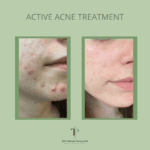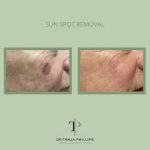
Acne Treatment Explained | Effective Solutions for Clearer Skin
02/08/2025
How to Remove Age Spots on Your Face
18/08/2025The colour of human skin depends on the pigment melanin. Too much melanin results in darker skin patches (hyperpigmentation) while deficiency produces patches which are lighter (hypopigmentation). Skin pigmentation irregularities occur because of multiple different causes. Sun exposure typically leads to age spots (brown solar lentigines) and freckles but hormonal changes during pregnancy produce melasma which appears as a blotchy brown face mask according to independent.co.uk. Acne and skin injuries create dark marks on the skin that develop after inflammation. People frequently want to diminish these harmless skin discolorations that naturally occur.
Understanding skin pigmentation
Different types of pigmentation problems exist in the human body. The most common pigmentation problems include melasma together with sun spots and post-acne marks. The skin condition melasma creates brown or grey spots that appear on cheek areas or forehead regions which result from hormonal influences and sun damage. Solar lentigines (age spots) are round brown spots caused by years of sun damage – wearing a high-SPF sunscreen can help prevent them. Post-inflammatory hyperpigmentation (PIH) develops as dark discolorations which remain after acne or skin inflammation has healed. Medical experts observe that numerous skin conditions diminish naturally throughout time. Skin requires gentle protection with specific products that control melanin generation. Over-the-counter creams can help even out tone, but it takes patience and consistency to see results.
Protect your skin from the sun
The fundamental action to protect your skin from sun exposure stands as the most crucial step. Broad-spectrum sunscreen with an SPF 30 or higher rating represents essential daily medicine against melanin production caused by UV rays according to medicinenet.com. People need to apply sunscreen after physical activity and swimming and wear protective clothing alongside a wide-brimmed hat to acquire extra protection. The listed strategies prevent new marks from forming and help existing spots to slowly disappear. Medical professionals state that applying sunscreen along with blocking measures serves as the primary defense against worsening pigmentation. All treatments become useless without proper sun protection according to experts at medicinenet.com.
Gentle exfoliation and skincare ingredients
A gentle exfoliation approach slowly diminishes dark spots by eliminating the top layer of pigmentation according to estemedicalgroup.uk. The application of AHA and BHA-containing creams and masks several times weekly helps remove pigment while simultaneously creating smoother skin. The skincare world contains ingredients that combat melanin production through vitamin C serums which decrease excess pigmentation and niacinamide along with azelaic acid and kojic acid which inhibit melanin synthesis. A doctor will provide hydroquinone or retinoid (vitamin A cream) prescriptions for patients who have persistent marks. Retinoids enhance cell renewal to decrease acne and aging pigmentation yet they increase skin sensitivity to sunlight.
Professional treatments and medical procedures
Chemical peels performed by dermatologists using strong acids and microdermabrasion enable skin pigment removal. IPL (intense pulsed light) and cryotherapy serve as alternative treatment options. Laser therapy has become the preferred treatment method for most specialists because laser pulses target excess skin melanin precisely. The clinical “Cosmelan” peels contain azelaic and kojic acid to halt pigment-producing cell activity. The professional treatments need minimal recovery time while multiple sessions result in faster spot fading compared to using creams alone. It is important to choose a qualified practitioner, as advanced treatments must be according to your skin type and the nature of the pigmentation.
Lifestyle and natural aids
A healthy lifestyle together with proper nutrition helps the body heal skin tissue. Your body benefits from eating fruits and vegetables while drinking water which promotes better skin turnover. Vitamins C and E which exist in various foods serve multiple skin benefits by defending against oxidative harm and controlling pigmentation processes. People use natural remedies such as aloe vera gel containing aloin and green tea extracts as traditional skin brighteners. The suggested steps need time to work because they do not provide instant solutions. The path to noticeable results requires both regular treatment and sufficient time. You need to test every strong new cream or serum by applying it to a small skin section before using it fully to prevent any adverse reactions.
Expert help and advanced solutions
Expert assistance exists for people who have persistent skin pigmentation problems. The process of laser treatment breaks down skin melanin which helps achieve uniform skin tone. Age spots can be effectively treated by Dr Tanja Phillips who operates as a UK-based laser specialist using modern technology. During personal consultations Dr Tanja Phillips performs pigmentation removal with advanced lasers such as Fotona StarWalker which ensure safe results and short recovery times. The skincare community recognizes Dr Phillips for delivering results that look natural while maintaining patient safety. People who need advanced pigmentation removal should consider Dr Phillips’ clinic as their trusted resource. Her website (tanjaphillips.com) provides both information about her services and booking details.
Taking the Right Steps Towards Clearer, Even-Toned Skin
Skin pigmentation management requires both time and dedicated effort from patients. The combination of sun protection with specific skincare routines and professional treatment when necessary enables dark patch fading to achieve an even skin tone. Your skin can achieve a clear and healthy appearance through proper methods and expert supervision. The complete execution of these steps leads to the highest probability of achieving a uniform skin tone. The fading of pigmentation demands extended periods of treatment because visible improvement typically requires multiple weeks to show and sometimes several months. People should maintain awareness of the newest developments in pigmentation care through their continuous introduction of research and products.


